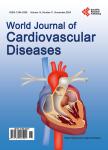Major clinical and angiographic outcome of drug eluting stents in native ostial coronary artery disease
Major clinical and angiographic outcome of drug eluting stents in native ostial coronary artery disease作者机构:Division of Cardiology Beni-Suef University Hospital Beni-Suef Egypt Division of Cardiology Heatherwood & Wexham Park Hospitals London UK Division of Cardiology Royal Brompton Hospital Imperial College London UK
出 版 物:《World Journal of Cardiovascular Diseases》 (心血管病(英文))
年 卷 期:2013年第3卷第3期
页 面:320-327页
学科分类:1002[医学-临床医学] 100201[医学-内科学(含:心血管病、血液病、呼吸系病、消化系病、内分泌与代谢病、肾病、风湿病、传染病)] 10[医学]
主 题:Bare Metal Stent DRUG Eluting Stent Ostial Coronary Lesions
摘 要:Objectives: The study was designed to evaluate the efficacy and safety of drug eluting stents (DESs) in aorto-ostial (A-O) coronary artery lesions, in terms of early and late restenosis rate;including clinical assessment, non-invasive stress testing and angiographic follow-up. Also, the study was aimed to compare the results of implantation of drug eluting stents (DES) to that of bare metal stents (BMS) in aortoostial lesions done over a previous 5 years in Royal Brompton Hospital. Background: The safety and effectiveness of DESs for the treatment of aortoostial lesions. Methods: We included 161 consecutive patients with symptoms subjective of angina pectoris or objective evidence of myocardial ischemia;who underwent percutaneous coronary interventions (PCI) in coronary ostial lesions using DES. The patients were divided into two groups based on the site of ostial lesion. The control group consisted of 125 consecutive patients who underwent percutaneous coronary intervention for ostial lesions using bare metal stents (BMS) implantation in the period immediately before the introduction of DES. The incidence of major adverse cardiac events (MACE), including death or Q-wave myocardial infarction (MI), need for repeated revascularization procedure CABG or angioplasty, were recorded in-hospital and at twelve months ± 3 months. Follow-up angiography was only performed in case of recurrent symptoms subjective of myocardial ischemia or if there was objective evidence of myocardial ischemia by stress testing. Results: The initial procedure was successful in 149 patients (92.5%) in the DES arm. There were no statistically significant major in-hospital complications in the DES group, compared to BMS group which showed 4 cases of in-hospital deaths (p = 0.017). At Twelve months ± 3 months follow-up, MACE were significantly less frequent in the DES group compared to the BMS group, including death (0.8% vs. 6.4%, p = 0.004) and need for CABG (1.7% vs. 10%, p = 0.012). Conclusions



